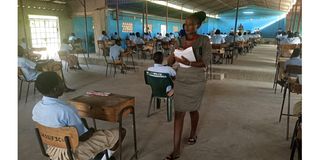Premium
Funding pressure piles up as candidates sit KCSE tests

An invigilator distributes KCSE examination papers to candidates at St Kevin's Secondary School on November 4, 2024.
What you need to know:
- Courts have applied brakes on the model that was touted as one to save universities from sinking into a financial morass manifested through a slide into debts of at least Sh70 billion.
- Opposition from some players, mainly continuing students who were not even beneficiaries, saw the model dragged to the dock, prompting its suspension that has thrown its implementation into disarray.
A fresh headache is beckoning government mandarins as 965,500 candidates embark on their main Kenya Certificate of Secondary Education (KCSE) examination papers today amid a funding crisis in public universities.
The 2024 KCSE candidates will form the third cohort of students lining up to pile more pressure on the government under the controversial student-centred funding model launched in 2022.
Courts have applied brakes on the model that was touted as one to save universities from sinking into a financial morass manifested through a slide into debts of at least Sh70 billion.
Opposition from some players, mainly continuing students who were not even beneficiaries, saw the model dragged to the dock, prompting its suspension that has thrown its implementation into disarray.
With the Ministry of Education having eased the grading structure at KCSE level – by dropping a more difficult requirement that made two sciences and English mandatory subjects – the number of students qualifying for university s expected to shoot past the 201,33 who met the C+ minimum entry requirement last year.
The import of this is that the third cohort of university qualifiers will balloon the budget meant to fund the funding model, if the courts clear the path for its implementation. This will create a bigger nightmare than has been the case in the last two years.
Undeniably, the two cohorts already under the model are heaping pressure on government coffers in what could explain the controversial spread in grouping of applicants, claimed to be skewed as to heap more students onto bands that need them to pay more in family contribution.
While the initial intentions of implementing the model sound genuine, its sustainability must remain the elephant in the room of economic advisers.
According to government projections, the number of students qualifying for university entry is expected to grow over the next three years, hitting 290,950 in 2027. Based on previous records, on average, 90 per cent of KCSE candidates who qualify for degree courses apply and are placed annually.
The upshot is that the demand for student financing will continue to rise, piling more pressure on the Exchequer, which is already facing untold strain, especially with the rising government appetite to fulfil election pledges.
What this means is that the government must boldly confront the question of sustainability of higher education funding before the crisis spins out of control.
If projections hold – and the government fully shows determination to fund needy and vulnerable students to the levels requested – the National Treasury will find itself seeking close to Sh200 billion per annum by 2027, when the fourth cohort of KCSE students land in university lecture halls.
The situation makes the case before the courts that caused the suspension of the model to look like an opportunity for the government to refine the programme.
One of the options would be to work out a proper projection of the true cost that will go into funding the model, based on the revised grading system that was applied for the first time on last year’s KCSE examinations.
Doing so will point the government to the actual proportion of students that will be joining universities to pave the way for the mapping out of the financial scenarios that would be required to put the young scholars in lecture rooms.
Though the government appears to look the other way and ignoring the possibility of introducing cut-off points as one of the ways of putting a cap on the number of students it can sponsor to universities, this looks like the inevitable way to steady the funding ship.

Moi University School of Medicine students demonstrate against new university funding model in Eldoret on September 09, 2024.
Under this arrangement, reminiscent of the 1990s and early 2000s, the government will determine the number of students it can fund before applying the guillotine to determine those that can adequately fit within the resource envelope.
This situation would mean that students qualified to join university but fall out of the cut-off net would seek private arrangements, including applying for Higher Education Loans Board funding, to pursue education as self-sponsored learners.
Granted, the government has made the right move to divorce funding from admissions, the Kenya Universities and Colleges Central Placement Agency (Kuccps) shall retain its role of placing students, regardless of their ability to pay fees.
Due to limited funding, the government will step in to decide the number it can comfortably fund before pronouncing itself on the cut-off.
Alternatively, adequate plans can be made to subject the placed students into a radical and credible vetting to determine a merit listing from which those needing the most support can be picked.
This route would generate more questions than answers, given the plethora of issues that has attended to the existing Means Testing Instrument.
With everything regarding the current funding model in limbo, all eyes will be fixed on the courts where the government is embroiled in a fierce battle to save one of its most preferred flagship programmes from the chop being pushed by spirited petitioners who want it dead and buried.
Dr Siringi, a former ‘Nation’ Editor, is a senior lecturer at the University of Nairobi. [email protected]




